 |
| Typical Nepali Traditional Home |
In this blog, I am going to try to mention the English translated form of traditional Nepali words or things and try to briefly explain them.
Agenu or Chulo (अगेनु वा चुलो)= hearth or fireplace
 |
| Nepali Traditional Fireplace (अगेनु) |
 |
| Nepali Traditional Hearth (चुलो) |
Both words agenu and chulo mean the hearth or fireplace of a house where household cooking is done. However, there is a slight difference: agenu is at the lower side of the floor and there is no demarcation as such for it. Chulo is located at the higher side of the floor and is sharply demarcated by making the floor one-level up. In a typical rural family, children or a menstruating female is not allowed to step near Chulo. Foods for humans are cooked in Chulo, while agenu is commonly used to cook food for the cattle or warm body in the winter. Chulo is expected to be more cleaner.
Daaura (दाउरा) = Firewood
 |
| दाउराको भारी (Two basketful of firewood) |
The dried wood that is chopped and ripped. Dried up tree branches are also called as daaura. Fig. daaura ko bhaari (basketful of firewood)
Bhungro (भुङ्ग्रो ) = Embers
 |
| Bhungro (भुङ्ग्रो ): Embers |
Red chunks of half burnt firewood before it turns into ashes are called aago ko bhungro. They are used as a fire-starter in another place or to warm up the bodies in winter.
Makal (मकल ) = Coal scuttle
 |
| Makal (मकल ): Coal scuttle |
Generally in the winter seasons, people flock around a portable fire container made up of mud or ceramics to get their hands and body warm. This fire pot is called Makal or coal scuttle. It may contain fire or just embers.
Takhat (तखत ) = Mantelpiece
 |
| Takhat (तखत ): Mantelpiece |
A place to hold essentials of cooking for example: spices or sugar pot that are placed just above the fireplace. In short it is also called mantel. In the picture above you can see the wooden frames placed just over the cooking area.
Chukul (चुकुल ) = Latch
 |
| Chukul (चुकुल ): Latch |
The coupling of wood or metal parts to lock the door or window from inside through the mechanism of sliding. Latch can also be used as verb, e.g., the door is latched.
Khopa or Khopo (खोपा वा खोपो ) - niche
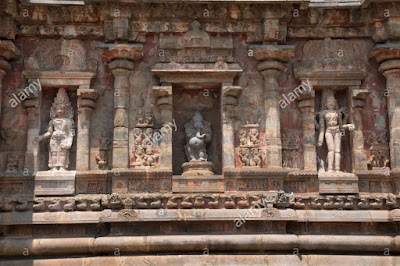 |
| Khopa or Khopo (खोपा वा खोपो ) - niche |
A hole along the wall that was caused as a process of construction to hold the scaffolding or sometimes made intentionally to keep stuffs from inside. For example, when you build a house, there are holes to insert planks and pillars along the sidewall. Those holes are khopa. And sometimes, these holes are made afterwards to hold stuffs like in some Hindu temples the stone idols of gods are kept in niche.
Daati (दांती) = eaves
 |
| Daati (दांती) : eaves |
The ulterior portion of roof that is visible from the ground. It is this portion of roof that pokes out from the wall but is sheltered by the roof above. In many houses, pigeons make nest in the eaves. The name daati comes as there are many planks arrayed horizontally, just like teeth with gaps in between.
Chuli (चुली) = Roof Apex
 |
| Chuli (चुली): Roof Apex |
The inverted v-shaped portion of roof that forms the apex of the house.
Balesi (बलेसी ) = Gutter
 |
| Balesi is the surface where these water falls |
The engraving where rainwater from the roof falls is called balesi. In western homes, gutter are made with metal just beneath the roof but typical Nepali homes don't have inbuilt gutter below the roof. Hence rainwater falls upon the front yard causing natural carves for drainage.
Sikwa (सिक्वा) = Sideways view
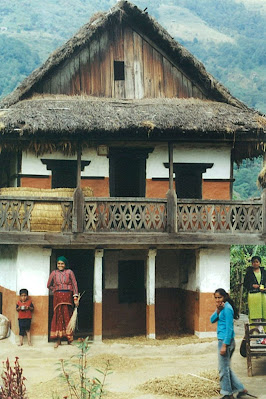 |
| Sikwa (सिक्वा) |
The front view of a house is called aghillo mohadaa (frontal façade), the side view is called Sikwa. In exact terms, it it the breadth (width) side of the house, i.e. not the length-side.
Bhakari (भकारी)= Bamboo Silo
 |
| Making Bhakari (भकारी); Bamboo Silo |
 |
| Bhakari (भकारी). traditional Nepali Bamboo Silo |
A large and tightly-knit bamboo mat that's used for storing grains and crops in a dry and safe place of house. First, the mat is wrapped to make a cylindrical void and its one end is fixed in the floor. The grains like paddy or wheat are poured and sealed from above.
Koreso (कोरेसो) = Grater
 |
| Koreso (कोरेसो) Grater |
A metallic kitchenware of variable holes with sharply bent edges that crush vegetables to desirable size. For example, when we want to crush the radish into small pieces to make pickle, we use this tool by dragging the radish along its corrugated surface so that its down surface gives fine long fibers.
Chakati (चकटी) = Disk
 |
| Chakati (चकटी) : Disk |
Chakati or Disc (disk) is a sacred seat made up of straw or holy grass (kush) on which Hindu priests sit and worship the idols. It is knit up of the cover of maize cob or dried paddy plants.
Pirka (पिर्का) = wooden mat or plank
 |
| Pirka (पिर्का): Nepali wooden mat |
It is the wooden mat or plank used in the kitchen to sit upon while eating.
Laaltin (लाल्टिन) = Lantern
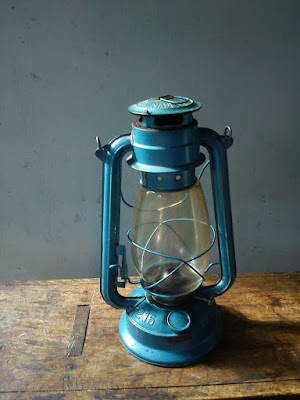 |
| Laaltin (लाल्टिन): Traditional Nepali Lantern |
It is a kerosene fueled traditional lamp hung at a height in the dark corners of a house
Haadi (हाँडी) = Pipkin
 |
| मकै भुट्ने हाँडी : Nepali traditional pipkin |
An earthenware for making popcorn out of corn grains
Kaptero (कप्टेरो) = Bamboo stick
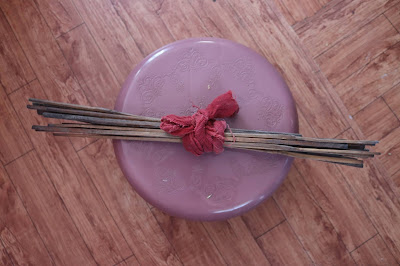 |
| Kaptero (कप्टेरो): Bamboo stick |
A collection of equal sized bamboo sticks is called Kaptero which is used to stir corn grains while making popcorn in a pipkin or Haadi.
Silauto and Lohoro (सिलौटो र लोहोरो) = Stone hand grinders
 |
| Silauto (सिलौटो ) |
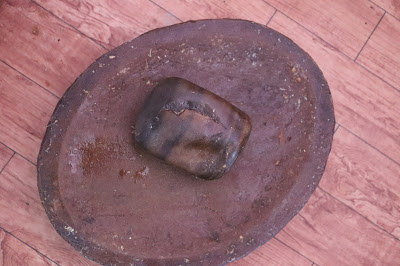 |
| Silauto and Lohoro (सिलौटो र लोहोरो) |
Silauto is a flat stone that lies on the ground/floor while lohoro is a small sized oval stone that is grasped by the hand and is repeatedly thumped upon silauto where something like garlic, ginger or cumin is placed. Before electric mixer arrived, tomato pickle was made by crushing with silauto and lohoro.
Odaan (ओदान) = fireplace tripod
 |
| Odaan (ओदान) |
It is a three legged ironware placed in the hearth or elsewhere so that a cooking pot can easily be adjusted even if it is under-sized.
Chiyaadaani (चियादानी) = tea kettle
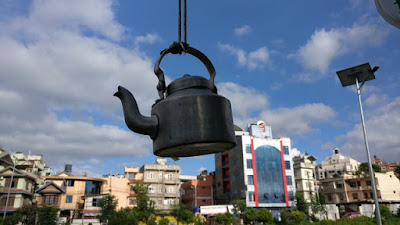 |
| Chiyaadaani (चियादानी) |
It is a traditional kitchenware to make tea
Taapke or Diuri (ताप्के, दिउरी) = saucepan
A metal kitchenware used to boil water or make tea which has a handle to grab. Generally speaking, tapke is made up of iron while diuri is made up of aluminium or steel.





0 Comments